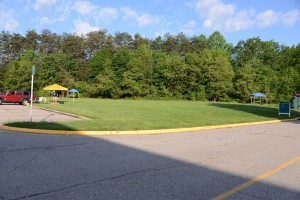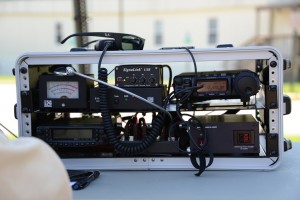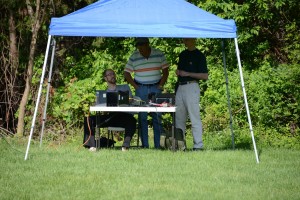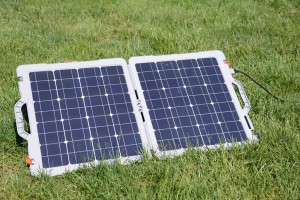
On Saturday, May 17, 2014, Prince William ARES took to the field in the green common in front of the McCoart building at the County Government Centre for a small digital exercise. The key goal was to set up one or more FlDigi stations and pass communications between them. A second goal was to set up a broadband hamnet mesh network. And finally, it was a great opportunity for the members of PWCARES to exercise their go-kits, digital gear, and work out in the field without commercial power.

Three “station” set-ups were provided. At the height of the exercise, as many as nine stations were in operation around the perimeter of the common and two different types of mesh networks were in operation. Most operators had a standard set up of a laptop, radio, and some type of external sound card device, such as SignaLink. A couple of stations tried the “headset to mic” interface method. At the end, four stations were able to successfully pass traffic, both ad hoc messages and more formal ICS-213 messages. These stations were all using SigaLinks.
Clarence provided a traditional broadband-hamnet network, with an access point connecting the field to the Internet.

Derek set up a mesh network that was a custom set up that was not BBHN or HSMM. The equipment he brought for the mesh was three WNDR3700v2 routers [1]. On these devices, I had loaded the OpenWRT firmware. One device ran DHCP and an XMPP server[2], while the other two acted simply as relays. The network was configured so the 5 GHz radio connected ad-hoc while the 2.4 GHz radio provided an AP, different name and channel from each node.

Significantly different from BBHN, the adhoc 5 GHz connections were connected with the B.A.T.M.A.N. protocol (BBHN uses OLSR). The bat0 interface thus provided was bridged with the 2.4 GHz APs. This has the effect of making the entire network link-local. Thus, wireless clients could pull addresses from the node running DHCP.

At the exercise, David KG4GIY and Keith KM4AA connected their laptops and used Pidgin to connect their XMPP accounts, while Mark Redlinger connected with his iPhone and the ChatSecure app. No downtime was noted, though use was not heavy. The ability to connect Android and iPhone devices through the second AP is a big advantage to having a dual-band radio. The clear weather and flat terrain meant all of the APs were visible from the entire area of the exercise.
Derek welcomes any questions on this topic.

We learned there were a great number of power options available to everyone. Deep cycle batteries, generators, even solar panels, which meant there was no need for commercial power during the exercise. We also discovered that a physical device between the computer and the radio worked better than other lash-ups for sending and receiving data via fldigi. Several observers were present and learned how to use the system and what value it brings. It was also a good learning experience and we need to have more opportunities. A suggestion was made to have little workshops to review settings and set ups and then have another exercise. The digital list will be used to coordinate. The mesh nodes demonstrated the ability to utilize traditional TCP/IP based technologies successfully. More research and work needs to go into establishing the best way to implement it.

Bill did a signal study during the exercise, the results of which will be provided as soon as he has completed his analysis.
Thanks to everyone for their participation!
NOTES:
1 – http://wiki.openwrt.org/toh/netgear/wndr3700
2 – XMPP is an instant message protocol, perhaps likened to a computerized form of the National Traffic System